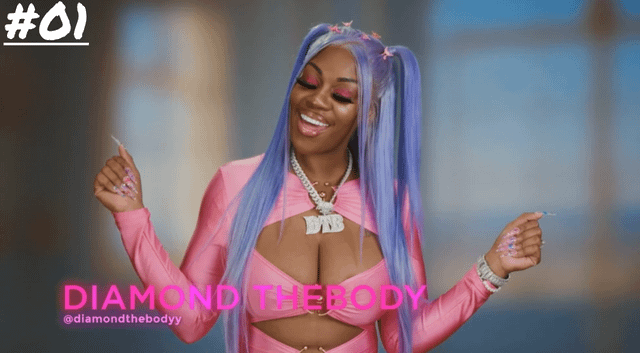Reality TV often gives viewers a polished, glamorous version of the lives of its participants, but behind the scenes, the pressure is real. In a particularly emotional episode of Baddies, one cast member, Diamond, had a heart-wrenching breakdown that exposed the toll the relentless drama and personal conflicts were taking on her. This emotional moment served as a raw reminder of the unseen struggles reality TV stars face when they step into the spotlight.
In an intimate conversation with Natalie Nunn, Diamond, tears streaming down her face, expressed a desire to leave the show. She admitted that the constant fighting and personal issues were weighing heavily on her, saying, “I quit. I’m done. I don’t want to do Baddies no more. I want to go home. That’s it.” These words, filled with despair, resonated deeply with viewers, as they revealed the often overlooked emotional toll of participating in reality TV.
But what led to Diamond’s breakdown? What is the real cost of being on a reality TV show? And how do moments like these shape the public’s understanding of the industry? In this blog post, we will explore Diamond’s emotional journey, dissect the pressures of reality TV, and reflect on how this breakdown serves as a window into the complexities of fame, mental health, and human vulnerability.

The Pressure Behind Reality TV: A Glimpse into Diamond’s World
Reality TV shows like Baddies are designed to keep audiences captivated with drama, conflict, and the unpredictable nature of human interactions. The concept is simple: bring together a group of strong-willed individuals and let them navigate their personalities, egos, and emotions. But while the cameras capture the fireworks, they often miss the toll that the experience takes on the stars.
Diamond, like many others who join these shows, was thrust into a high-pressure environment where every move, every word, and every emotional response is under scrutiny. The constant exposure to conflict, the pressure to perform, and the never-ending drama can feel overwhelming. For Diamond, it became too much. Her breakdown, which played out on screen, revealed a side of reality TV that viewers rarely get to see: the emotional vulnerability of someone who is not just trying to navigate a show, but trying to maintain their mental and emotional well-being in an environment that demands a lot.
The Breaking Point: Diamond’s Decision to Leave
In the episode where Diamond broke down, the rawness of her emotions was palpable. It was clear that she was no longer just participating in a show — she was fighting to keep her sense of self intact. The words she spoke were heartbreaking and revealing: “I quit. I’m done. I don’t want to do Baddies no more. I want to go home. That’s it.”
This moment is significant for several reasons. Firstly, it challenges the typical portrayal of reality TV contestants. We often see contestants like Diamond being portrayed as larger-than-life characters, always ready for a confrontation, never afraid to get involved in the drama. But in this moment, Diamond showed vulnerability, something that the producers of the show usually work to avoid highlighting. It’s a rare, unfiltered moment where we get to see someone who has reached their emotional limit.
Secondly, Diamond’s breakdown highlights how reality TV can be a double-edged sword. While the fame and exposure can be tempting, the personal toll can be immense. Diamond’s emotional plea to leave the show was not just about the drama; it was about the psychological weight that was bearing down on her. It was about the loneliness, the exhaustion, and the internal conflict that comes with being constantly filmed, judged, and placed in high-stakes situations. It’s important to remember that these are real people, facing real emotions, even if we only see a fraction of their experiences on screen.
Behind the Scenes: The Dark Side of Reality TV
The production of reality TV shows is not as glamorous as it seems. In fact, it’s often grueling, stressful, and emotionally taxing. From long days of filming to the constant exposure to conflict, it’s no surprise that many cast members experience breakdowns or mental health struggles during and after their time on the show. What viewers often fail to realize is the incredible emotional toll that participating in these shows can have on individuals, particularly when they are forced to constantly navigate difficult interpersonal dynamics and personal issues.
On Baddies, the camera doesn’t just capture the moments of confrontation—it captures the emotional aftermath of those encounters. As the tension between the cast members escalated, Diamond found herself at the center of a storm she could no longer weather. The repeated cycles of conflict, paired with the expectation to always be “on” for the camera, took a significant toll on her mental health. Her breakdown was a moment of clarity, a sign that the show’s demands had crossed a line into harmful territory.
One of the major challenges of reality TV is that it forces participants to live their lives in front of an audience. They are thrust into situations that test their limits, sometimes in ways that are mentally and emotionally unhealthy. Participants like Diamond are forced to portray aspects of their personalities that may not align with their true selves in order to maintain viewer interest. The lines between the character they play on screen and their real-life identity often become blurred. This emotional dissonance can be overwhelming.
Furthermore, the lack of privacy exacerbates the issue. Reality stars have their lives constantly exposed to the public, leaving little room for personal reflection or recovery. There’s often a sense of isolation, with participants finding it hard to trust anyone around them, knowing that every conversation and interaction could be used for entertainment. For Diamond, the pressure to constantly perform and engage with the drama eventually led to her emotional collapse. In her quiet moments with Natalie Nunn, she revealed the truth behind the facade, admitting that she was simply exhausted by it all.

Viewer Reaction: Empathy vs. Judgment
Following Diamond’s emotional breakdown, social media erupted with reactions from fans and viewers. Some expressed genuine empathy, recognizing the heavy emotional toll the show was taking on her. They understood that Diamond’s breakdown wasn’t just an on-screen performance; it was a real cry for help. Others, however, were quick to judge, accusing her of seeking attention or using her emotions for drama. This divide in public opinion highlights a larger issue: the way we view reality TV stars as entertainment rather than human beings.
In reality TV, contestants are often reduced to one-dimensional characters designed to fulfill specific roles—whether it’s the villain, the underdog, or the drama queen. As a result, viewers can sometimes forget that the people behind these personas are complex, multi-faceted individuals with real emotions, vulnerabilities, and struggles. Diamond’s breakdown served as a stark reminder that reality TV stars are not just characters for our amusement; they are people who are enduring very real challenges.
The way that audiences react to emotional moments like Diamond’s breakdown speaks to a larger societal issue: the lack of empathy and understanding for the mental health struggles of public figures. In many cases, reality TV stars are expected to entertain without showing any vulnerability. When they do show their true emotions, they are often met with criticism or ridicule rather than support.
As viewers, we need to shift our perspective and begin to recognize that the people we watch on reality TV are more than just performers. They are individuals who are navigating complex emotional journeys, often under immense pressure. Supporting them means recognizing their humanity and understanding that emotional breakdowns, like the one Diamond experienced, are a natural part of being human—not a gimmick for ratings.


